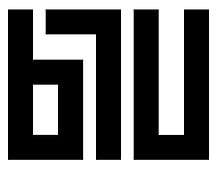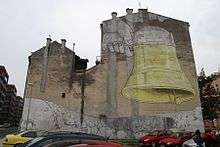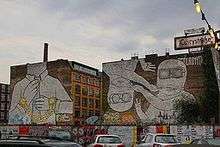Blu (artist)
Blu is the pseudonym of an Italian artist who conceals his real identity. He was born in Senigallia. He lives in Bologna and has been active in street art since 1999.

His early career involved the practice of shared artistic actions. Artists such as Dem, Sweza, Run and, above all, Ericailcane,[1] were his companions during nocturnal raids where an anonymous creative participation overcame the need of signing their pieces. Also, during those years, Blu started experimenting with digital animation, and he created short interactive video clips that were used as a visual contribution to the live musical performances of the collective OK NO.[2]
The collaboration with Ericailcane had its best results from 2003 to 2006. The two personalities complemented each other; while Blu was painting his characteristic human figures Ericailcane made his typical animals. The two artists, friends in real life, continue to work together, although less often.
Starting in 2004, some art galleries noticed Blu's artistic value and invited him to take part in both one-man and collective shows. Yet Blu, throughout his entire youthful career, attempted to limit his presence within the official art world, preferring other kinds of territories.
Since his major pieces outside of his videos have been immovable murals, the survey below of Blu's work is geographical rather than chronological.
Places
Central and South America
His nomadic spirit reached its peak in 2005. From the end of that year Blu spent most of his time jumping around in self-guided travels, linking his itineraries to the festivals to which he was invited. At that time he collaborated with Ericailcane and several artists from Costa Rica, Nicaragua, Guatemala, and Honduras in a festival in Managua called "Murales de Octubre." On that occasion he painted a wall, significant in the history of South American murals, on the Avenida Bolivar where, in 1979, Victor Canifrù celebrated the Sandinista revolution.[3] With this he achieved one of his most imposing murals which was immediately dubbed Hombre Banano (Banana Man) by the locals, referring to the protest of the workers on banana plantations.[4]
The following year, from October 2006 to December 2006, he returned to Central and South America for a long circuit of murals that included Mexico City, Guatemala City, Managua, San José (Costa Rica), and finally, Buenos Aires (Argentina). A year later he was again in South America, in São Paulo, Brazil, participating in the festival "A Conquista do Espaço" (Conquering Space). On that occasion he came up with a new interpretation of the "Christ of Corcovado" of Rio de Janeiro. In Blu's version Christ is literally submerged by tons of guns and rifles. From the Fall of 2007 to the Spring of 2008, he lived in Buenos Aires, devoting all his efforts to the creation of a video called Muto[5] (Silent). In addition to receiving many international awards, such as the Grand Prix 2009 from the Festival of Clermont-Ferrand,[6] "Muto" has been seen by 12 million-plus viewers on YouTube. It is also available in high definition on Blu's website under the Creative Commons license.[7] This video is composed of hundreds of paintings on walls, made throughout many streets of Buenos Aires and, frame by frame, creates more than seven minutes of an animated mural.
In 2009 Blu started his umpteenth tour around South America visiting Bogotá for the festival "Memoria Canalla", then to Montevideo, Uruguay, back to Buenos Aires and, for the first time, to Lima, Peru, where he painted the entire façade of an historical building in the central Avenida Arenales. In this huge mural Blu seems to reinterpret the history of South America, a continent that has been violated by both ancient and modern conquistadores.
In 2013 he participated in the Bienal de Arte Urbano (BAU) in Cochabamba, Bolivia.[8]
North America
In 2008 Blu accepted an invitation from the Deitch Gallery in New York to paint the exterior of their Long Island location. After being invited by the Museum of Contemporary Art, Los Angeles to paint an exterior wall of the museum for its "Art in the Street" exhibition, its director Jeffrey Deitch ordered the resulting mural to be whitewashed the day after it was finished, probably due to its political content. The mural represented two rows of coffins each draped with a one dollar bill in place of the American flag.[9]
West Bank
In 2007, Santa's Ghetto,[10] a London-based art collective which organizes annual happenings of painting performances and print trade fairs, invited Blu to a festival that took place in the West Bank. Blu was part of a group of artists, including Banksy, Mark Jenkins, Ron English, Swoon, and Faile who painted on the wall around Bethlehem that separates the West Bank from Israel.[11] On a watchtower border Blu painted a figure of a person trying to tear down the walls with his finger.[12]
Europe
Austria
In 2010 Blu was invited to Vienna to paint a mural at the Danube River harbour near Albern in the city district of Simmering. First suggested in 1923 as one possibility for the expansion of Vienna's harbour facilities, Albern was selected for realisation by the German Reich Ministry of Transport (Reichsverkehrsministerium) in 1939, a year after the "Anschluss" of Austria to Nazi Germany. The project was to serve as a logistic node of a future geo- and biopolitical order, designated for the transshipment of grain from the annexed or economically colonized regions of eastern and south-eastern Europe to the heartlands of the German Reich. For the construction of the harbour basin and its five granaries between 1939 and 1942 the Nazi regime employed forced labour. Realized on one of the granaries, Blu's mural called upon the overdue historical and social commemoration of the place's charged history and the unknown fates of the forced labourers who built it. The commissioned piece was destroyed in autumn 2013 in the course of renovation works.[13][14]
Eastern Europe

In Eastern Europe Blu has painted in Belgrade, Serbia in 2009, in Wrocław and Gdańsk, Poland, in 2008. In Gdańsk, located on the industrial harbor where the destinies of twentieth-century Europe intersected, he used an abandoned hangar as the background for his short movie, "Morphing,"[15] where the symbols of this place, loaded with history, are mixed together. Gdańsk Harbor was indeed invaded first by the Nazis, then by the Red Army and subsequently saw the birth of the trade union movement, Solidarność (Solidarity), and finally, the victory of capitalism. Also, in 2008, Blu was in Prague in the Czech Republic for the "Names Festival"[16] to paint a mural called Gaza Strip, where tanks and bulldozers are seen chasing each other along a Möbius strip.
England
In 2007, Blu went to London for the first time where he made many pieces around Camden Town and Willow Street, and at the former headquarters of art-gallery website Pictures on Walls.[17] That same summer he took part in a two-man exhibit with Ericailcane at the Lazarides Gallery.[18] The following year, the Tate Modern[19] presented an exhibition on the phenomenon of street art and invited Blu,[20] along with JR,[21] Faile, Sixeart, and Os Gêmeos[22] e Nunca, to paint its entire main façade.[23]
Germany

Blu worked in Germany on many occasions between 2006 and 2009, mostly in Berlin, and always around Cuvrystraße in a multi-ethnic neighborhood called Kreuzberg. Thanks to his participation in several of the festivals "Backjump"[24] and "Planetprozess,"[25] he had the opportunity to create some of his works, one of which was painted in combination with gigantic photos by the French artist JR.
In 2006, during one of these trips, Blu made his first digital animation from images painted directly on a wall, a technique that would be a recurrent theme of many of his future videos such as "Muto."
In consultation with Blu the two murals at Cuvrystraße were covered with black paint in 2014 by a group of people as a sign of discontent with the city's urban development policies in the area.[26]
Italy
Italy, above any other country, can boast of having the majority of Blu's graffiti, both illegal and legal. Among the public projects worth noting are the façade of PAC[27] (the Contemporary Art Pavilion) in Milan, finished in 2008; the murals in that city's Bicocca and Lambrate train stations, done in 2008 and in 2009; three editions of "Spinafestival" in Comacchio (2005, 2006 and 2007); two editions of "Fame Festival a Grottaglie[28]" (2008 and 2009). In this last one, Blu completed a video-animation with the New York-based artist, David Ellis. Blu has also taken part in many editions of the festival "Icone[29]" in Modena and in Ancona's "Festival Pop Up" in 2008 where he painted along with Ericailcane a gigantic silos next to the harbor waterfront. Other Italian cities where Blu has left his mark are varied, among which are Prato, Florence, Grosseto, Turin, Ancona, Rovereto, Verona and Pesaro. In Bologna there were most of his first works because of his studies in the city's University. In 2016 he deleted all murals painted in Bologna due to the decision taken by the municipality who made an exhibition trying to profit from Blu's graffiti without his permission.[30][31]
Blu has also painted in several "Centri Sociali", places that are between squats and self-managed cultural centers. In Bologna his work is visible at XM24, TPO, Livello 57, Crash; in Rome at Forte Prenestino and Collatino; in Milan at Cox 18 and Leoncavallo and in Pisa at Cantiere San Bernardo.
Spain
.jpg)
Blu has frequently visited Spain. At the festival "Segundo Asalto" in Zaragoza, he, along with the artists San, Eltono,[32] Nuria,[33] and Nano, painted a mural of a colossal minotaur picking up an astonished man. Blu's murals can also be found in Valencia, Linares, Madrid and Barcelona. In Barcelona's Barrio Carmelo neighborhood, Blu took part in the 2008 edition of the festival "The Influencers".[34] With the global economic crisis looming, Blu painted a threatening shark whose skin is completely covered in euro bills.
Techniques, themes and ethic
The list of the places where Blu has left his trace is as long as his collection of sketchbooks which contain sketches, thoughts or simply visual notes. Often these drawings function as a script for his improvisations on walls.
His graphic mania is directly proportional to the epic scale of his murals. His paintings seem to interpret the architectural language of public spaces and reinvent them into new shapes. Thus, his murals are never detached from the places where they were conceived because Blu is a painter in the landscape, urban or industrial. He always tries to communicate with the society which inhabits those spaces, searching for the uniqueness of each place. Besides drawing and painting, the technical universe of Blu is completed by a skillful use of the digital medium. Proof of that can be seen in his website where his manual craftsmanship is combined with computer programming language. The recurring themes of his imagery play on the distortion of the human figure. He speaks a pop vocabulary which resembles the automatic writing process of the surrealist tradition with purely rhetorical processes.[35]
In short, Blu's artistic practice has contributed to a radical change in the art market. His murals and his videos are given for free to the public space of the cities and on the World Wide Web. His income comes from the sale of multiples, like silkscreen prints, in those few galleries which represent him, or through the sale of self-made editions. The works of Blu appear abrupt because they are derived from the free creativity of an artist who has decided to occupy a position outside the sheltered field of art. As magically as they appear they can disappear, sometimes covered by other paintings by Blu himself, sometimes ruined by time and weather, but mostly erased by the authorities in the name of tidiness.
Blu's aesthetic search is motivated by a belief in an open source philosophy,[36] persistent in its anarchical revolt against contemporary art conventions and unique in beauty.
Censored in US
- He was invited in Los Angeles for the exhibition "Art in the Streets" but his work on the side of the Geffen Contemporary Wing of MOCA was censored.[37]
Principal exhibits
- 2009 - Memoria Canalla, Bogotá.
- 2008, 2009 - Fame Festival, Grottaglie, Taranto, Italy.
- 2008 - Street Art, Tate Modern, London.
- 2008 - Influencers, Barcellona.
- 2007 - Santa's ghetto, Bethlehem, Palestine.
- 2007 - Super Fluo, Lazarides Gallery, London.
- 2007 - BackJump Live Issue#3, Kunstraum Kreuzberg/Bethanien, Berlin.
- 2007 - Street Art Sweet Art, Padiglione Arte Contemporanea, Milan.
- 2007 - A Conquista do Espaço, São Paulo.
- 2005 - Murales de Octubre, Managua.
- 2005, 2006, 2007 - Spinafestival, Comacchio, Italy.
Videography
- 2001 OK NO, 3'44", music: Foia and Maledetto. OK NO on Youtube
- 2005 Child, animation, 3'27", music: Maledetto. Child on Vimeo
- 2006 Fino, animation, music of Andrea Martignoni. Fino on Vimeo
- 2006 Ffwd, animation, music: irr.app.(ext.). FFWD on Vimeo
- 2007 Fantoche; wall-painted animation, location: Baden, subsequently included in "Muto". Fantoche on Vimeo
- 2007 1, 2, 3, etc, ; Connections, animation, 10".
- 2007 La quiete, animation, music: LaQuiete "Sulla differenza fra un sorriso e una risata". La quiete on Vimeo
- 2007 Letter A, wall-painted animation. Letter A on Vimeo
- 2007 Walking, wall-painted animation. Walking on Vimeo
- 2007 Muto, wall-painted animation, music: Andrea Martignoni Muto on Vimeo
- 2009 Combo, (with David Ellis) wall-painted animation, Studio Cromie production, Fame festival, Grottaglie, 2009. Combo on Vimeo
- 2009 Morphing, wall-painted animation, location: Gdańsk. Morphing on Youtube
- 2010 Big Bang Big Boom, wall painted animation, location Argentina, Uruquay BIG BANG BIG BOOM on Vimeo
- 2012 BLU painting in Köln, wall painted animation, location Köln, Germany BLU painting in Köln on Youtube
- 2012 BLU and ERICAILCANE at Lazzaretto, wall painted animation, location Bologna, Italy BLU and ERICAILCANE at Lazzaretto on Youtube
- 2012 BLU in Valencia, wall painted animation, location Valencia, Spain BLU in Valencia on Youtube
Bibliography
- Back Jumps (2007). The Live Issue #3: Urban Communication and Aesthetics, William Stratmann.
- Dietrich, Lucas (2009). 60: Innovators Shaping Our Creative Future, Thames & Hudson.
- Hundertmark, Christian (2006). The Art of Rebellion 2: World of Urban Art Activism (No. 2)
- Iosifidis, Kiriakos (2009). Mural Art, Volume 2: Murals on Huge Public Surfaces Around the World from Graffiti to Trompe L'Oeil, Gingko Press.
- Lazarides, Steve (2009). Outsiders: Art by People
- Lewisohn, Cedar, editor (2008). Street Art: The Graffiti Revolution, HNA Books.
- Manco, Tristan (2007). Street Sketchbook: Inside the Journals of International Street and Graffiti Artists, Chronicle Books.
- Tschiedl, Roman (2014). BLU - Untitled/it is obvious, In: Taig, Maria [Ed.]: Kör vie 07-10: Public art Vienna 2007 - 2010, Verlag für moderne Kunst
Editions
- Blu (2018). Minima muralia, Zooo Print and Press.
- Blu (2008). Blu 2004-2007, Studio Cromie.
- Blu (2006). Nulla, Zooo Print and Press.
- Blu (2005). 25 disegni (with Ericailcane), Zooo Print and Press.
References
- Ericailcane's Website
- Blu, Oklahoma NO video, 2001, via Youtube
- David Kunzle, The murals of revolutionary Nicaragua, 1979-1992, University of California Press, 1995.
- Henry J. Frundt, Fair Bananas, Farmers, Workers, and Consumers Strive to Change an Industry, University of Arizona Press, 2008.
- Blu, Muto, 2008, via Youtube Archived March 26, 2010, at the Wayback Machine
- Clermont-Ferrand Film Festival Website
- Creative Commons’ Website
- "Blu-BAU". BAU-mARTadero. Retrieved 25 March 2020.
- "Los Angeles MOCA Censors Street Artist's Commissioned Mural". Huffington Post.
- Santa's Ghetto's Website
- Sheera Claire Frenkel, "Let us spray: Banksy hits Bethlehem", The Times, December 3, 2007.
- "Santa's Ghetto Bethlehem, Art-Das Kunst Magazine, Dec. 12, 2007". Archived from the original on 2009-03-04. Retrieved 2010-03-06.
- Roman Tschiedl: BLU - Untitled/it is obvious, in: Maria Taig, Barbara Horvath (Hg.): Kör vie 07-10: Public Art in Vienna, 2007-2010, Verlag für moderne Kunst, Nuremberg 2014, p 206; see also Untitled/it is obvious, koer.or.at, 2010
- Ortrun Veichtlbauer: Braune Donau. Transportweg nationalsozialistischer Biopolitik, in: Christian Reder, Erich Klein (Hg.): Graue Donau – Schwarzes Meer, Springer, Vienna/New York, 2008, p 240 f (in German)
- Blu, Morphing, 2008, via Youtube.
- "Names Festival's Website". Archived from the original on 2012-07-14. Retrieved 2010-03-06.
- Pictures on Walls’ Website
- Lazarides Gallery's Website
- Tate Gallery, Street Art Exhibition's Website Archived March 23, 2010, at the Wayback Machine
- Francesca Gavin, "Street art is now mainstream, The Guardian, April 8, 2008.
- J-R's Website
- Gemeos’ Website
- "Street art to adorn Tate's walls", BBC, April 2, 2008
- Backjump Festival's Website
- Planetprozess’ Website
- ”When the finger points to the moon… “, Blog, blublu.org, retrieved 6. June 2015
- Padiglione dell’Arte Contemporanea di Milano (PAC) Website
- Fame Festival's Website
- "Icone Festival's Website". Archived from the original on 2010-03-04. Retrieved 2019-10-18.
- "Street Artist #Blu Is Erasing All The Murals He Painted in #Bologna - Giap". Giap. 2016-03-12. Retrieved 2018-02-18.
- "BLU blog March 12th, 2016". blublu.org. Retrieved 2018-02-18.
- El Tono's Website
- Nuria's Website
- The Influencers Festival's Website
- Jean Baudrillard, L'Échange symbolique et la mort, Paris, 1976.
- Naomi Klein, No Logo, Knopf, 2000.
- Censorship at MOCA